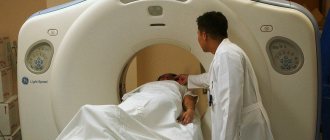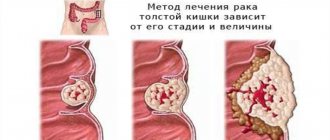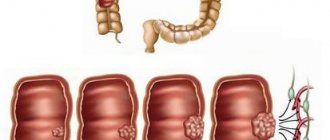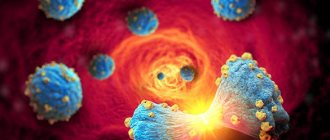Mesentery
(
mesenterium
) - a duplication of the peritoneum with nerves, blood and lymphatic vessels, lymph nodes and fatty tissue enclosed between its layers, passing from the abdominal wall to one or another organ of the abdominal cavity (Fig. 1 and color. Fig. 6).
Rice.
1. Posterior wall of the abdominal cavity: 1 and 10 - v. cava Inf.; 2 - recessus omentalis sup.; 3 - pancreas; 4— mesocolon transversum root; 5 - flexura duodenojejunalis; 6 - radix mesenterii; 7 — root of mesocolon sigmoideum; 8 — mesorectum (BNA); 9— rectum; 11— aorta abdominalis; 12 - duodenum. Rice. 6. Convolutions of the mesentery: 1 - hepar; 2 - cardia ventriculi; 3 - vesica fellea; 4 - pancreas; 5 - lien; 6 - pylorus; 7 - duodenum; 8 - mesenterium; 9 - colon ascendens; ί ο - colon descendens; 11 - ileum; 12 - appendix; 1 3 - colon sigmoideum; 1 4 - rectum; 15 - vesica urinaria. The word "mesentery" is also used in a broader sense. Thus, they are described: Mesentery of the tendon (mesotendineum), Mesentery of the uterus (mesometrium), Mesentery of the ovary (mesovarium) and Mesentery of the fallopian tube (mesosalpinx).
Lat. the name of the mesentery of different organs is formed from the combination of meso- with the name of this organ. For example, mesentery of the small intestine - mesenterium, mesentery of the large intestine - mesocolon, mesentery of the uterus - mesometrium.
How does small intestine cancer develop?
Oncology begins with the appearance of just one altered cell in the body. It arises due to exposure to harmful substances, various diseases or simply random failures, grows and multiplies. Over time, there are many of them, they form a tumor and destroy the tissues in which they develop. Most of these cells are identified and destroyed by the immune system, but some of them are able to resist it - they secrete special proteins, thanks to which our natural defense does not consider them dangerous.
The possibilities of cancer do not end there - its cells enter the bloodstream and lymphatic system. The lymphatic system complements the cardiovascular system. The lymph circulating in it - the intercellular fluid - washes all the cells of the body and delivers the necessary substances to them, taking away waste. In the lymph nodes, which act as “filters,” dangerous substances are neutralized and removed from the body. systems, spread throughout the body, become established in various organs and create metastases in them - new foci of the disease.
To better understand the disease, we need to understand how our digestive system works.
After we chew and swallow food, it enters the esophagus, a narrow muscular tube through which it passes into the stomach, where it is partially digested. There it turns into a thick liquid and is excreted into the small intestine, where large molecules continue to be broken down into small ones and most of the nutrients are absorbed.
The small intestine of an adult is about 4.5-6 meters long and consists of 3 sections:
- Duodenum
, which receives substances necessary for digestion and decomposing carbohydrates, proteins and fats - produced by the liver and pancreas. This is where most cancers begin. - The jejunum and ileum,
where nutrients from the foods we eat are absorbed into the blood.
The ileum drains into the colon, where water and some minerals are absorbed, and the resulting waste moves to the rectum, where it is stored until it leaves the body through the anus.
Types of Small Bowel Cancer
Doctors identify several types of dangerous neoplasms in this part of the digestive system, each of which develops in certain cells:
- Adenocarcinomas
are cancers of the small intestine that begin in the glands lining the inner surface of the organ. They account for approximately 1 in 3 cases of cancer. - Carcinoid,
or
neuroendocrine, tumors
arise in cells that help control the secretion of digestive juices and the movement of food through the gastrointestinal tract. - Lymphomas
appear in immune cells - lymphocytes, whose main task is to fight infections and tissue damage. - Sarcomas
develop in various types of connective tissue, such as muscle. Their most common subtype, gastrointestinal stromal tumors, begin in so-called Cajal cells, which signal the muscles of the gastrointestinal tract to contract.
The structure of the mesentery
Some organs located in the peritoneal cavity have a serous membrane. The folds of peritoneum that surround the loops of the small and large intestines are called the mesentery. But it is worth noting that not all parts of the digestive tract have peritoneal layers.
For example, at the level of the duodenum they are completely absent, and the mesentery of the small intestine is most developed. The posterior portion of the mesentery, which is attached to the wall of the abdomen, constitutes the root of the mesentery. Its size is small and reaches approximately 16 cm.
The opposite edge, which affects the entire small intestine, is equal to the length of these two sections. Next, the mesentery goes to the intestinal loops and surrounds them in such a way that they are tightly fixed between the layers of the peritoneum.
Why does small intestine cancer develop?
To date, the exact causes of the development of small intestinal cancer are not known to scientists and doctors - they only know about the factors that increase the likelihood of its development. Having one, two or three of them does not mean that a person will necessarily become a patient of an oncologist.
These include:
- Crohn's disease
, which causes the immune system to attack the gastrointestinal tract. - Poor nutrition
– an excess of red meat, salty, fatty and smoked foods in the diet, as well as a lack of fruits and vegetables. - Celiac disease
is an abnormal reaction of the body to the protein gluten, which is found in wheat and other types of grains. The immunity of its owners damages the intestinal mucosa, forcing it to produce new cells, each of which may turn out to be tumor cells. - Familial adenomatous polyposis
is the presence of many polyps - tissue growths on the intestinal wall, which over time can turn into a malignant, that is, life-threatening neoplasm. - Age
: this type of cancer most often develops in people aged 60 to 70 years. - Cystic fibrosis
is damage to the glands, respiratory and digestive systems due to the accumulation of thick mucus in organs and tissues. - Smoking and alcohol
: Some studies have shown that inhaling toxic tobacco smoke and drinking alcoholic beverages can trigger the development of the disease. - Other polyposis syndromes
: Lynch, which increases the chances of developing any type of dangerous tumor in people under the age of 50, or Peutz-Jeghers, which leads to the appearance of polyps in various parts of the body. - Having colon cancer
increases the likelihood of developing small intestinal cancer.
Endoscopic department of the oncology center Lapino 2
Signs and symptoms of small bowel cancer
The symptoms of the disease are similar to other fairly common health problems. Often people do not pay attention to them or take them for a normal digestive problem, as a result of which a considerable part of patients consult a doctor several months after their appearance.
Abdominal pain is often the first symptom of cancer.
– it comes and goes, often occurs after eating, but does not cause serious discomfort to its owner.
As the tumor grows, the intestinal lumen narrows, the passage of digested food through it slows down, and the discomfort intensifies. When it becomes large enough and completely blocks the passage, a person experiences obstruction of the digestive tract, which leads to severe pain, nausea and vomiting
.
Sometimes the tumor begins to bleed. If the blood flows slowly, the patient's number of red blood cells - cells that carry oxygen from the lungs and deliver them to other tissues - gradually decreases, causing weakness and fatigue
.
If this happens quickly, the patient becomes dizzy and faint,
and his
stool
becomes
black
and
tarry
.
Quite rarely, duodenal cancer causes jaundice
– yellowing of the skin, mucous membranes and whites of the eyes. This occurs when the tumor grows and the bile duct is blocked, due to which the contents of the liver cannot enter the intestines. As a result of this blockage, bile, necessary for digesting food, and the substance it contains, which colors the tissues yellow, enter the bloodstream.
In rare cases, cancer leads to the appearance of perforations - holes in the intestinal wall through which the contents of the organ exit into the abdominal cavity. Signs of this condition may include severe abdominal pain, nausea and vomiting.
Inflammation
The inflammatory process as a separate pathology occurs extremely rarely. Most often it occurs against the background of peritonitis, since the serous membrane is involved in this disease. It is almost impossible to recognize inflammation of the mesentery, since the clinical picture can be varied.
The most common symptom of the pathology is pain in the navel area of varying intensity. The mesenteric lymph nodes increase in size, swelling and redness of the inflamed area appears. Over time, the mesenteric tissue is replaced in places by connective tissue, turning into dense scars. As a result, the walls of the mesentery grow together and shrink.
Treatment of any disease is aimed at eliminating the inflammatory process. Several groups of drugs are used for therapy: antibiotics, antispasmodics and painkillers. In addition, a mandatory condition on the path to recovery is diet. In the case of a purulent process, surgical intervention with complete sanitation of the abdominal cavity is indicated.
Diagnosis of small intestine cancer
Diagnostics is necessary not only to identify oncology - its data allows us to understand how far the disease has spread and what treatment is best for a person.
You can undergo a full examination for small intestinal cancer at Onko. We have the most modern equipment and a team of highly qualified specialists who guide the patient from diagnosis to any treatment.
Diagnosis begins with a physical examination, questioning about symptoms, possible risk factors and family health problems. Then the doctor prescribes a whole list of studies:
- Blood tests
: show its composition and the number of oxygen-carrying red blood cells, the level of which may decrease due to bleeding caused by cancer. - FGDS
-
fibrogastroduodenoscopy
: examination of the duodenum using an endoscope - a thin flexible tube with a light source and a camera at the end. The device is inserted into the mouth, passes through the esophagus and stomach, and allows not only to assess the condition of the tissues, but also to remove small pieces of them, which are then sent to the laboratory. - Capsule endoscopy
: A painless procedure involving swallowing a small capsule about the size of a large tablet. It passes through the entire digestive system, takes thousands of pictures transmitted to a special wearable device, and leaves the body naturally. - Balloon enteroscopy
: insertion through the mouth or anus of a special endoscope equipped with one or two balloons that are secured in place, allowing a close and detailed examination of the intestinal wall. - Colonoscopy
: insertion of a thin, flexible tube with a light source and a camera at the end through the anus. This procedure is used to study the condition of the final part of the small intestine and take tissue samples from suspicious areas. - Imaging tests, such as CT
or
MRI
: create clear images of organs using X-rays, magnetic fields, or radioactive substances. They are prescribed to detect a tumor, search for signs of re-development of the disease and identify metastases - additional foci of oncology, - Biopsy: taking small pieces of tissue and sending them to a laboratory for testing is the only method that allows you to make an accurate diagnosis and determine whether suspicious areas are cancerous. This procedure is usually performed simultaneously with endoscopic examinations or colonoscopy.
Stages of small bowel cancer
After a person is diagnosed with small intestine cancer, doctors determine the stage of the disease - find out how far it has spread and what tissues it has damaged. Staging allows specialists to correctly assess the situation, imagine the patient’s approximate prognosis and select the most appropriate treatment for him.
For these purposes, the American TNM system is used, each letter of the abbreviation of which describes tissue damage:
- T the
main tumor; - N
describes the condition of the lymph nodes - small organs of the lymphatic system. The lymphatic system complements the cardiovascular system. The lymph circulating in it - the intercellular fluid - washes all the cells of the body and delivers the necessary substances to them, taking away waste. In the lymph nodes, which act as “filters,” hazardous substances are neutralized and removed from the body, retaining and neutralizing hazardous substances; - M1
indicates the presence, and
M0
- the absence of metastases - additional foci of cancer in other organs located far from the main tumor.
As a rule, cancer begins to develop in the mucous membrane
– the inner lining of the intestine, and as it grows it damages the deeper layers:
- second , the submucosa
, consisting of connective tissue; - muscular
, contracting to move food; - subserous
and
serous
, or visceral peritoneum - thin films covering the gastrointestinal tract.
Doctors distinguish 5 stages of adenocarcinoma: 0: tumor cells are present only in the epithelium - the upper layer of mucosal cells. I: they have penetrated deep into the first or second layers of the organ wall. IIA: muscular or subserous membranes are damaged. IIB: the visceral peritoneum or tissues located next to the intestines are damaged. IIIA: Cancer is found in 1 or 2 nearby lymph nodes. IIIB: cancer is present in 3 or more lymph nodes. IV: metastases have appeared in the body - additional tumors in other organs or tissues located far from the small intestine.
Treatment of small intestine cancer
Treatment of any type of oncology is a complex task, the solution of which requires several doctors: a surgeon, gastroenterologist, radiologist, chemotherapy and others.
Onco has a whole team of world-class specialists who care for the patient completely - from examination and diagnosis to prescribing and carrying out any therapy. With us, you don’t have to wonder “what to do next?” – we draw up a clear action plan and carry out all the necessary interventions on time – without queues, delays or wasted time.
Therapy is selected for each person individually - it depends on his age, general health, as well as the type and stage of the disease.
The main treatment for this type of cancer is surgery
. The neoplasm is removed completely if it is located only in the place where it originated - in the small intestine or the tissues closest to it. As it grows and the changed cells spread throughout the body, such an intervention alleviates the patient’s condition and reduces the symptoms caused by the blockage of the digestive system.
Chemotherapy
– introduction into the body of special drugs that enter the bloodstream and destroy cancer cells in any part of the body. It is prescribed in several situations:
In the case of adenocarcinoma of the small intestine, which is not very sensitive to “chemistry,” drugs such as Capecitabine, 5-fluorouracil, Oxaliplatin and Irinotecan are often used. Since these substances affect not only cancer cells, but also healthy cells, people who take it often develop severe side effects. The most common ones are nausea and vomiting, loss of appetite, hair loss, mouth ulcers, diarrhea, shortness of breath - feeling short of breath, bleeding or bruising from minor cuts or injuries, and constant fatigue.
Radiation therapy
– destruction of the tumor using radiation. This method is prescribed to destroy remaining cancer cells after surgery and as palliative treatment. The goal of such an intervention is to alleviate the patient’s condition and improve his quality of life - stopping bleeding or reducing pain. Before it is carried out, a team of specialists makes careful measurements: they find the correct angles at which the rays are delivered and select the exact dose for each individual person. The procedure itself lasts only a few minutes and does not cause discomfort. Its main side effects are fatigue, nausea and vomiting, diarrhea, and skin changes in the treated area such as redness, peeling or blistering.
Immunotherapy
– taking medications that strengthen a person’s own immunity and help him detect and destroy cancer cells.
Be sure to inform your doctor about any changes in your health - he will select the most suitable treatment regimen for you or prescribe medications that will alleviate your condition.
Oncoproctology department of the oncology center Lapino 2
Lymphadenitis
Infections affecting the lymph nodes of the mesentery spread to the tissues of the organ, causing lymphadenitis to form on its membrane. Below is a photo of a study of intestinal lymphatic capillaries.
Patients experience severe symptoms:
- acute pain;
- redness and pain in the navel area;
- nausea and profuse vomiting;
- redness and rashes on the skin;
- hyperemia of the pharynx.
If you notice symptoms, you should immediately seek medical help. Advanced stages of lymphadenitis can lead to complications and death. Medical care consists of complex treatment with antibiotics and a special diet.
Treatment of operable and inoperable small intestinal cancer
Treatment methods for this type of cancer depend on the possibility of complete surgical removal of the tumor.
Operable neoplasms
– those that can be completely cured with surgery are removed along with a small amount of nearby healthy tissue:
- when it is located in the first part of the organ, pancreatoduodenectomy is usually performed - resection of the head of the pancreas and duodenum;
- if it is detected in the final section, as a rule, removal of part of the colon is required;
- if the cancer is located in other areas of the small intestine, the patient is prescribed resection of the area containing the altered cells.
If nearby lymph nodes are damaged, your doctor may recommend chemotherapy or radiation therapy to kill any damaged cells remaining in the body.
Inoperable
Tumors are considered to be those that have damaged nearby tissue, spread to other organs, or are found in a person unable to undergo major surgery. In such cases, it is possible to carry out chemotherapy, radiation or immunotherapy to stop the growth of the tumor, slow down its development, reduce symptoms and improve the patient’s quality of life.
What role does it serve?
The main function of the mesentery is to separate most of the organs from the posterior abdominal wall and prevent the organs from descending into the pelvis when the body is in an upright position. The vessels of the mesentery provide the intestinal walls with a sufficient amount of oxygen, which is simply necessary for normal functioning.
Nerve cells send impulses to the brain and receive them back. The lymph nodes located at the base of the mesentery provide the protective function of the entire intestine.
Prognosis and survival for small intestinal cancer
The outlook for each person is individual and depends on a large number of factors - age, general health, type of disease, its stage and response to treatment.
To understand the approximate prognosis for cancer development, doctors use a special term - “five-year survival rate”. It doesn’t say anything about the chances of a particular patient - it’s just statistical data that shows what percentage of patients with a certain type of cancer at a particular stage remain alive 5 or more years after the tumor was discovered.
- at localized stages, while the tumor is located only in the small intestine - approximately 85%
- at regional level, when nearby tissues or lymph nodes are damaged – about 76%;
- with the spread of altered cells to organs far from the intestines, such as the liver - 42%.
For carcinoid tumors of the gastrointestinal tract: 97%, 95% and 67%, respectively. For stromal formations: 93%, 80% and 55%.
The overall five-year survival rate for small intestinal lymphoma is approximately 70%.
Oncological diseases
Violation of organ cell division leads to the appearance of a cancerous tumor on the mesentery membrane. At the initial stages of the disease, symptoms are not pronounced or may be completely absent.
As the tumor size increases, patients experience the following symptoms:
- sharp pain of a periodic nature;
- weight loss;
- exhaustion of the body and increased fatigue;
- weakness;
- not digesting food;
- vomiting and heartburn;
- diarrhea or constipation.
Treatment methods depend on the diagnosis. In the case of a benign or malignant tumor, they can differ significantly. Both medical and surgical treatment are used.











